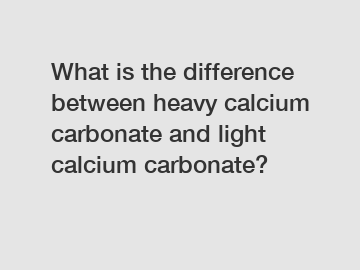What is the difference between heavy calcium carbonate and light calcium carbonate?
Calcium carbonate is a common mineral that is found in rocks and minerals all over the world. It is used in a variety of industries, including construction, agriculture, and pharmaceuticals. There are two main types of calcium carbonate: heavy calcium carbonate and light calcium carbonate. While they may sound similar, there are some key differences between the two that are important to understand.
Heavy calcium carbonate, also known as ground calcium carbonate, is produced by grinding natural limestone or marble into a fine powder. This process involves crushing the rock, grinding it to a fine powder, and then purifying it to remove any impurities. The end result is a high-density powder that is commonly used in industrial applications such as manufacturing plastics, rubber, and paper.
On the other hand, light calcium carbonate is typically produced by heating limestone to high temperatures, which causes it to release carbon dioxide and create calcium oxide. The calcium oxide is then mixed with water to form calcium hydroxide, which is further processed to become light calcium carbonate. This type of calcium carbonate is less dense than heavy calcium carbonate and is commonly used in products such as toothpaste, antacids, and dietary supplements.

One of the key differences between heavy and light calcium carbonate is their particle size. Heavy calcium carbonate has larger particles, which makes it more suitable for applications where a high level of whiteness and brightness is required, such as in paper production. Light calcium carbonate, on the other hand, has smaller particles, which contributes to its smooth texture and ease of dispersibility in liquids.
Another important difference between the two types of calcium carbonate is their chemical composition. While both are composed of calcium, carbon, and oxygen, heavy calcium carbonate typically contains higher levels of impurities such as magnesium, iron, and manganese. These impurities can affect the quality and performance of the product, so heavy calcium carbonate is often purified before use in industrial applications.
In terms of performance, heavy calcium carbonate is known for its high whiteness, brightness, and opacity, making it ideal for applications where a bright white color is desired. It is also often used as a filler or extender in products such as paints, coatings, and plastics, where it helps to improve properties such as stiffness, impact resistance, and weatherability.
Light calcium carbonate, on the other hand, is valued for its smaller particle size, which allows it to be easily suspended in liquids and absorbed by the body. It is commonly used in products such as toothpaste and antacids, where it can help to neutralize acids and provide a smooth texture. In the agriculture industry, light calcium carbonate is used as a soil conditioner to improve soil pH and provide essential nutrients to plants.
Overall, while heavy and light calcium carbonate may seem similar at first glance, their differences in particle size, chemical composition, and performance make them suitable for different applications. Whether you are looking for a high-density filler for industrial products or a smooth-textured ingredient for personal care products, understanding the distinctions between heavy and light calcium carbonate can help you choose the right material for your specific needs.
Want more information on Heavy Calcium Carbonate supplier, Radium powder, Light Calcium Carbonate wholesale? Feel free to contact us.

Comments
0